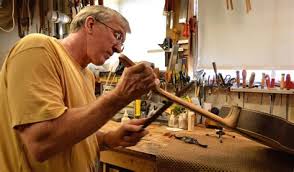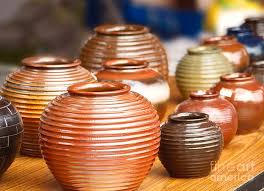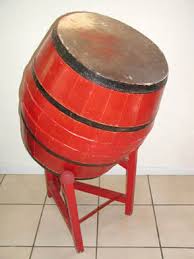Bài học cùng chủ đề
Báo cáo học liệu
Mua học liệu
Mua học liệu:
-
Số dư ví của bạn: 0 coin - 0 Xu
-
Nếu mua học liệu này bạn sẽ bị trừ: 2 coin\Xu
Để nhận Coin\Xu, bạn có thể:

Luyện tập SVIP
Listen and read.

Text:
Nick: There are so many pieces of pottery here, Phong. Do your grandparents make all of them?
Phong: They can't because we have lots of products. They make some and other people make the rest.
Nick: As far as I know, Bat Trang is one of the most famous traditional craft villages of Ha Noi, right?
Phong: Right. My grandmother says it's about 700 years old.
Mi: Wow! When did your grandparents set up this workshop?
Phong: My great-grandparents started it, not my grandparents. Then my grandparents took over the business. All the artisans here are my aunts, uncles, and cousins.
Mi: I see. Your village is also a place of interest of Ha Noi, isn't it?
Phong: Yes. People come here to buy things for their house. Another attraction is they can make pottery themselves in workshops.
Nick: That must be a memorable experience.
Phong: In Viet Nam there are lots of craft villages like Bat Trang. Have you ever been to any others?
Mi: I've been to a conical hat making village in Hue!
Nick: Cool! This is my first one. Do you think that the various crafts remind people of a specific region?
Mi: Sure. It's the reason tourists often choose handicrafts as souvenirs.
Phong: Let's go outside and look round the village.
Translation:
Nick: Ở đây có quá nhiều gốm quá Phòng ạ. Có phải ông bà cậu làm ra tất cả chúng không?
Phong: Không đâu vì nhà tớ có rất nhiều sản phẩm. Họ chỉ làm một ít và những người khác làm phần còn lại
Nick: Theo mình được biết thì Bát Tràng là một trong số những làng nghề truyền thống nổi tiếng nhất ở Hà Nội, phải không?
Phong: Đúng vậy. Bà mình bảo nó được 700 năm tuổi rồi đấy.
Mi: Wow! Ông cậu mở xưởng từ khi nào?
Phong: Cụ tớ mở chứ không phải ông đâu. Sau đó ông tớ kế tục lại. Tất cả thợ ở đây đều là cô, chú và anh chị em họ của tớ.
Mi: À tớ hiểu rồi. Làng cậu cũng là một địa điểm thú vị ở Hà Nội phải không?
Phong: Đúng vậy. Mọi người tới đây mua đồ cho ngôi nhà của họ. Một điều hấp dần nữa là họ có thể tự làm gốm ở xưởng đấy.
Nick: Đó hẳn là một trải nghiệm đáng nhớ lắm.
Phong: Ở Việt Nam cũng có rất nhiều những làng như Bát Tràng. Các cậu đã đến đó bao giờ chưa?
Mi: Mình từng đến làng nghề làm nón lá ở Huế!
Nick: Tuyệt! Đây là lần đầu tiên của mình. Các cậu có nghĩ mỗi nghề đều gợi nhớ người ta về một vùng miền đặc trưng không?
Mi: Chắc chắn rồi. Đó là lí do người ta thường chọn đồ thủ công làm quà lưu niệm
Phong: Hãy ra ngoài và thăm thú ngôi làng nào.
Vocabulary:
craft /krɑ:ft/ (n.): nghề thủ công
artisan /ɑtɪ:'zæn/ (n.): thợ làm nghề thủ công
handicraft /'hændikrɑ:ft/ (n.): sản phẩm thủ công
workshop /'wɜ:kʃɒp/ (n.): xưởng, công xưởng
attraction /ə'trækʃn/ (n.): điểm hấp dẫn
take over /teɪk əʊvə/ (phr. v.): tiếp quản, kế nhiệm, nối nghiệp
Match.
Arrange the word.

People who do skilled work, making things with their hands are called _____.
- r
- n
- i
- a
- sa
- s
- t
Match.
A visit to a traditional craft village
Nick: There are so many pieces of pottery here, Phong. Do your grandparents make all of them?
Phong: They can't because we have lots of products. They make some and other people make the rest.
Nick: As far as I know, Bat Trang is one of the most famous traditional craft villages of Ha Noi, right?
Phong: Right. My grandmother says it's about 700 years old.
Mi: Wow! When did your grandparents set up this workshop?
Phong: My great-grandparents started it, not my grandparents. Then my grandparents took over the business. All the artisans here are my aunts, uncles, and cousins.
Mi: I see. Your village is also a place of interest of Ha Noi, isn't it?
Phong: Yes. People come here to buy things for their house. Another attraction is they can make pottery themselves in workshops.
Nick: That must be a memorable experience.
Phong: In Viet Nam there are lots of craft villages like Bat Trang. Have you ever been to any others?
Mi: I've been to a conical hat making village in Hue!
Nick: Cool! This is my first one. Do you think that the various crafts remind people of a specific region?
Mi: Sure. It's the reason tourists often choose handicrafts as souvenirs.
Phong: Let's go outside and look round the village.
Read the text again and choose T/F.
(Nhấp vào dòng để chọn đúng / sai)| Bat Trang is a place of interest in Ha Noi because people can buy things for their house and make pottery themselves there. |
|
| Nick, Mi and Phong are at Phong's grandparents' workshop in Bat Trang. |
|
| Phong's grandparents started his family's workshop. |
|
| The craft village that Mi visited is in Ho Chi Minh City. |
|
| Tourists like to buy handicrafts as souvenirs because the handicrafts remind them of a specific region. |
|
| Bat Trang Village is about 70 years old. |
|
Read and choose.
That marble sculpture will surprise people.



Match.




(Kéo thả hoặc click vào để điền)
Vocabulary:
pottery /ˈpɒt(ə)ri/ (n.): đồ gốm
lacquerware /'lækəweə(r)/ (n.): đồ sơn mài
sculpture /'skʌlptʃə(r)/ (n.): điêu khắc, đồ điêu khắc
Complete the sentences.
The birthplace of the famous bai tho is Tay Ho village in Hue.
If you go to Hoi An on the 15th of each lunar month, you can enjoy the lights of many beautiful .
Van Phuc village in Ha Noi produces different types of products such as cloth, scarves, ties, and dresses.
On the Tet holiday, many Hanoians go to Dong Ho village to buy folk .
(Kéo thả hoặc click vào để điền)
Listen and choose.
We have to follow more than ten stages so that we can make a simple .
(Kéo thả hoặc click vào để điền)
Choose the correct word.
My grandparents took
- over
- away
- in
- up
Read and choose.
In Vietnamese traditional festivals, people often use _____ to make sounds.




Bạn có thể đăng câu hỏi về bài học này ở đây
